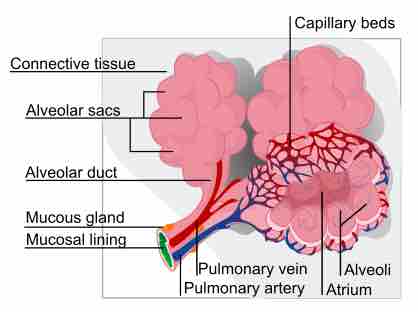The pulmonary circulatory system is the portion of the cardiovascular system in which oxygen-depleted blood is pumped away from the heart to the lungs via the pulmonary artery. Oxygenated blood is then returned to the heart via the pulmonary vein.
From the right ventricle of the heart, blood is pumped through the pulmonary semilunar valve into the left and right pulmonary arteries (one for each lung) and travels through the lungs. The pulmonary arteries carry deoxygenated blood to the lungs, where they release carbon dioxide and pick up oxygen during respiration.
The pulmonary arteries divide into thin-walled capillaries closely associated with the alveoli, small air sacs in the lungs where gas exchange occurs. Air is inhaled through the nose or the mouth and fills the lungs. Oxygen passively flows from the air inside the alveoli into the blood in the alveolar capillaries, while carbon dioxide passively flows in the opposite direction. The air, along with the diffused carbon dioxide, is then exhaled.

An Alveolus
The alveoli are the site of oxygen and carbon dioxide exchange in the lungs.
The oxygenated blood then leaves the lungs through pulmonary veins, which return it to the left atrium of the heart, completing the pulmonary cycle. This blood is pumped through the bicuspid valve into the left ventricle, then distributed to the body through the systemic circulation before returning to the right atrium.